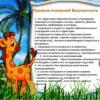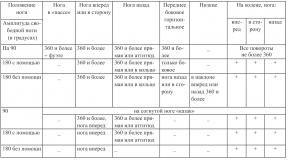Effective methods for learning English on your own. Effective methods for learning English
Every seven-year-old American child knows English. He didn't put any extra effort into it. His intelligence is no higher than yours. This is a fact that proves that anyone can speak English. But in order to move towards the goal along the shortest path, you need to choose the right methods. This article is about super techniques that will help you learn English in the shortest possible time.
The first thing you encounter when you start learning a foreign language are unfamiliar words. A huge number of foreign words that need to be remembered. The most common method of memorization is cramming, which is also the most tedious and ineffective. There are a couple of techniques for quickly memorizing words. Let's start with them.
Memorizing words. Mnemonics.
Popular wisdom says: “It is better to see once than to hear a hundred times.” A person quickly and effortlessly remembers vivid pictures. Mnemonics teaches us to use this feature of our memory to remember various information: historical dates, numbers, shopping lists, etc. Mnemonics methods are excellent for memorizing foreign words. They are many times more effective than cramming, because cramming ignores the principles by which human memory works, and mnemonics, on the contrary, uses these principles to ensure the most effective memorization of words.
How does mnemonics work? Young children remember the order of the colors of the rainbow using the mnemonic phrase:
"Every hunter wants to know where the pheasant sits."
the phrase is easy to remember, especially if you imagine what it will look like - a hunter with a gun at an advantage looks at a bright iridescent pheasant sitting on a branch.
In one of Sergei Lukyanenko’s novels, the main character uses a killer mnemonic phrase as a password to a top-secret computer system:
"Forty-nine monkeys stuck a banana in their ass."
It is impossible to forget such a password. Especially if you imagine a picture of how it happened, it will be remembered the first time for the rest of your life.
We are interested in memorizing English words. Here is an example of how this is done using mnemonics. Word
eagle [eagle] - eagle
remember with a phrase "EAGLE Claws are 10 Hellish NEEDLES". Imagine an eagle - what a huge powerful bird it is, imagine its feathers, imagine that it is above you and that its claws are piercing your shoulder, but instead of claws the eagle has 10 needles from a syringe, and there is a red cross on its side, imagine the pain you are experiencing. Introduced? Now you remember this word for a long time, you can check it.
Memorizing words. Card method.
The card method is very simple. You will need to buy small sheets of paper at a stationery store, approximately 5 by 5 centimeters in size. Let's say you have prepared 20 words that you need to remember. You do the following:
- Write the word and transcription on one side of the piece of paper, and the translation on the other. One word - one leaf. In total you will get a stack of 20 cards.
- You memorize all 20 words using mnemonics.
- A week after memorizing, the words need to be repeated. Take a stack and for each card do the following:
- look at the word written on the card, try to remember the translation.
- Turn the card over and check that it has been translated correctly.
- If you forgot a word, put the card aside.
- Similarly, check the translation of a word from Russian into English.
- After a while, you will have a whole stack of cards that you have put aside. You need to work with them more carefully, repeat them until you remember them.
Besides the effectiveness of this method, I like that you can carry a stack of flashcards with you at all times and repeat the words anywhere. There is always something to do while in line or on the way to work. A minimum of free time is spent - only on preparing cards.
You may ask: “Why is the flashcard method more effective than traditional cramming?” There is a strict scientific explanation for this.
The fact is that a person has two types of memory: short-term and long-term. The characteristic of short-term memory is fast and easy memorization and equally quick forgetting. With long-term memory, the opposite is true - both remembering and forgetting take a long time.
If we repeatedly retrieve information from short-term memory, then this information gradually begins to move into long-term memory. Cramming is based on this principle. Mnemonics immediately transfers information into long-term memory, which is more effective.
If we repeatedly retrieve information from long-term memory, then that information becomes less susceptible to forgetting. The card method is based on this principle. Cramming, on the other hand, does not use long-term memory, so it is ineffective for repeating information.
So, the flashcard method will allow you not to forget the words you have already learned and at the same time spend very little time on repetition. Read a detailed description of the method .
Grammar. Milashevich method.
Grammar. Dragunkin method.
Unlike Milashevich's method, which is applicable only to reading English texts, Dragunkin's method is comprehensive; it allows you to understand English grammar in all its diversity. At the same time, the form of material delivery differs sharply from traditional methods. The author of the method abandoned outdated, often simply artificial “rules”, and gave his own description of English grammar - simple, logical and understandable.
Dragunkin uses his own terminology - functional, clear, absolutely transparent and understandable. It uses many original parallels with Russian grammar and its own transcription, with the help of which any beginner can easily read and learn English words! In addition, the author of the method systematized exception words and solved the “problem” of articles and “irregular” verbs. And what is especially important is that the most difficult “times” are mastered using Dragunkin’s method in a couple of days.
If your goal is to master English grammar in full in order to write and speak rich English, then Dragunkin’s method will allow you to achieve results in the shortest possible time and without extra effort. Read a detailed description of the technique .
Ilya Frank's method.
The most expensive English language courses are conducted in English-speaking countries - the USA, Great Britain, Australia. People pay thousands of dollars to be immersed in a language environment because words and grammar are memorized automatically, without effort. There is another, accessible way to immerse yourself in the language environment - read books in English. The method is good, if not for the tiring need to constantly refer to the dictionary.
We often feel confused when we need to make a decision about something new to us. How to choose a good team for repairing an apartment, which school to send your child to, and how to learn English? Everyone around is aggressively imposing their methods - who to believe? To get a complete picture of the issue, you need to study the facts. We want to take the liberty to honestly tell the whole truth about the ways we know of learning English.
We will look at the four most effective ways to study: on your own, in a group, with a private tutor and in an online school. We'll talk about their costs, advantages and disadvantages, and at the end we'll present a summary table so you can make an informed decision.
First, we suggest that you familiarize yourself with our simple scheme for pre-selecting a training format.

Now let's take a closer look at the pros and cons of each method of learning English.

| pros | Minuses |
|---|---|
| Your own pace The ability to 100% adapt to your schedule and individual pace. You are your own teacher and student. | Lack of self-discipline Few people can force themselves to exercise regularly. If you learn English in bursts - once every couple of months for almost 5 hours at a time, then this will not bring any tangible benefit. You need to study systematically, at least 2 times a week for 1 hour. |
| Minimum financial investment | Need for personal contact The online format is not suitable for everyone. For productive classes, some people need the personal presence of a teacher, which provides great emotional support. And that's normal - all people are different. |
| Own learning platform Some schools conduct training via Skype, others use their own developed online classes, in which you can both communicate with the teacher and use text, video and audio materials, and do homework. | |
| Immersion in a communication environment Many schools provide you with the opportunity to communicate in conversation clubs, watch webinars, read blogs, use apps and online simulators - all without interrupting your English skills. Teachers also constantly communicate with colleagues, take exams and improve their qualifications. | |
| Classes with native speakers Many schools provide the opportunity to study with you - you will be able to hone your pronunciation, master the grammar and vocabulary that foreigners actually use. At the same time, methodologists and school managers control the work of speakers, and lessons with them will not turn into conversations for life. |
Who is it suitable for?:
- Lean
Online school is usually more expensive than group courses, but cheaper than private English tutors.
- Time conscious
Something will always require more of your attention, be it work or children. Online school fits your schedule, not the other way around.
Who won't suit it?:
- Small children under 9 years old.
Their restlessness requires the personal presence and attention of the teacher.
- For those who are distrustful of new technologies and prefer traditional ways of learning a language.
Price:
A lesson of 45–50 minutes with a Russian-speaking teacher costs from 500 to 800 rubles, with a native speaker - from 1,200 to 1,400 rubles. Many online schools provide various bonuses and promotions: you can get lessons at a significant discount or even for free.
Where to begin:
You can study
By the end of the twentieth century, English had finally secured the status of a language of global importance. In most schools in the world, its study has become compulsory, and teaching methodology has begun to develop by leaps and bounds. Not everyone could afford to attend courses, which prompted the emergence of the first method of self-studying English. Subsequently, many authors have attempted to create a program for effectively learning English on their own, but we will focus on the 8 most popular ones.
Schechter method
In this method of learning English, the basis is not the classical model “from theory to practice”, but the reverse, more natural system of perception. It is extremely similar to how we acquire our native language. The author gives an example of how small children learn to speak - after all, no one explains to them the rules for constructing sentences, cases and parts of speech. In the same way, Igor Yuryevich Shekhter suggests learning English.
The essence of modern methods of learning English is that from the first lesson, students are given a certain task, for example, to learn about the profession of their interlocutor. Next, all students act out so-called “studies”, where they try on various roles and try to solve the problem. Due to the fact that communication occurs between people with approximately the same level of language proficiency, the fear of using foreign speech, which occurs when communicating between a teacher and a student, disappears.
This English language technique consists of three stages: at the first, lexical units, words and expressions are given, and only then, at the second and third, the use of grammatical-syntactic structures is corrected. The system has repeatedly confirmed its effectiveness and is currently one of the most successful from the point of view of educational psychologists.
Pimsleur method
Dr. Paul Pimsler developed a special system of thirty-minute lessons, designed not only for the perception of information, but also for its reproduction. Each lesson is narrated by two people: our compatriot and a native English speaker. Thanks to this, as well as a special memorization technology, any student learns up to a hundred English words and expressions during each lesson. The essence of the lesson is to sequentially complete tasks that are spoken by speakers.
The undoubted advantages of the technique include its portability - you can perform audio tasks anywhere: standing in a traffic jam, heading to work, on the subway on the way to a date, or lying in bed before going to bed. The downside will be the lack of high-quality pronunciation testing and knowledge acquisition.
Dragunkin method
A feature of Alexander Nikolaevich Dragunkin’s system is its focus on the native Russian language when studying any foreign language. Very boldly calling English simple, the author claims that its roots go back to the Old Russian language, especially the system of grammatical tenses. Students of Dragunkin's course learn new words transcribed in Russian letters, and grammatical structures are divided not into 12 tenses, which we know from school, but into past, present, future and their variations.
Alexander Nikolaevich has his own network of schools where you can take three types of courses: basic, short and conversational. For self-study, the book “ Small jump into English”, which outlines the linguist’s innovative approach to language learning. Using his system, you can easily understand the use of English verbs, remember the rules for using articles, and easily master the basic principles of sentence construction. However, Dragunkin’s method has many negative reviews criticizing the pronunciation and the insufficient amount of theoretical knowledge.
Petrov's method
Dmitry Petrov claims that you can learn English in 16 hours. True, the author further clarifies that we are not talking about mastery of the language at the level of a native resident of Great Britain, but about basic knowledge. His lessons are enough to survive in an English-speaking environment, explain your needs and understand the answer.
English language methodology " Polyglot» Petrova has proven her effectiveness on the air of the TV channel “Culture” (since 2010 - “Russia K”). The basis of the technique is artificial immersion in the language environment. From the first lesson, show participants are required to speak a foreign language. To do this, the author provides the necessary lexical minimum on a given topic, as well as models of speech structures. Most of the lesson is devoted to repeated repetition of given structures, their “honing” and, thus, lasting memorization occurs.
Frank method
Ilya Frank is the author of an original method of learning English, based on reading literature adapted in a special way. Small fragments of text are presented with consecutive translation in brackets. So one large sentence is divided into separate phrases, and as soon as the reader finishes reading the phrase, the translation is immediately given in brackets. In this way, it is possible to compare the original text and the translation and fill in the meaning of those words that were not previously known. After the entire fragment is read in parts with translation, the same text follows, but without the “crutch” - the Russian analogue.
Using Ilya Frank's method, the student learns the meanings of new lexical units subconsciously, as well as ready-made patterns of use and construction of phrases. The main disadvantage of the method is the accumulation of only passive knowledge in English - the adapted texts do not provide exercises for applying the acquired knowledge. It is worth using the methods of learning English according to Ilya Frank as an additional means of increasing vocabulary.
Umin Method
Having published the book " Foreign easily and with pleasure", Evgeniy Aleksandrovich Umin (Umryukhin) on 50 pages outlined the method of motor and auditory engrams of pronouncing and perceiving phrases in English automatically. The author calls engrams “memory traces” that help the brain more easily assimilate information. Based, like Schechter, on the example of speech learning in young children, as well as on his research into the mechanisms of the human brain during learning, Umin developed a system of daily activities. According to him, by doing just 15-20 minutes a day, you can achieve significant success in a year. If you increase the duration of classes to 1-1.5 hours, then within a year you can begin to speak English at the same level as a native speaker.
Zamyatkin method
Book " It is impossible to teach you a foreign language"became a revelation for many. In it, Nikolai Fedorovich Zamyatkin reveals the reasons for unsuccessfully learning English at school, and also describes the method of “matrix tai chi”, which actually helps to learn a foreign language. His methods of learning English are based on gradual immersion in the language environment and the formation of an artificial “information hunger” - the brain’s need for new information.
According to the method, first you listen to dialogues, then read books, and then watch English-language films. Each stage is worked out carefully; it takes 3-5 days to listen to one dialogue in order to parse every phoneme and understand every word. By incorporating meditation techniques, you can achieve amazing results. However, the author honestly warns that “there is no miracle” - mastering the language will take a lot of time and a significant level of self-discipline.
Rosetta Stone Method
The last technique on our list will appeal to those who spend most of their time at the computer. A specially developed computer flash program gradually immerses the user in a foreign language environment, just as children are immersed in the world of adults. The stages are designed with a tendency towards gradual complication, the student moves from simple to complex. First, individual simple words are offered for memorization, then more complex lexemes are given, then speech structures are introduced, and then syntax and grammar.
Conclusion
The methods of learning English described above can really help you learn English on your own, but only to a certain level. Do not forget that to use it effectively, you need to be able to not only understand text and speech by ear, but also master conversational skills. And it is almost impossible to independently determine how correctly certain words are pronounced. From this it follows that effective learning of English requires at least an interlocutor (who can be found in our conversation club). But it’s best if this interlocutor can not only talk, but also competently explain incomprehensible moments of speech and can act as a mentor, and our English teachers via Skype will cope with this task perfectly.
Our school offers its students a comprehensive approach to language learning. In individual lessons, difficulties with grammar will be successfully resolved. Group classes in the conversation club and webinars will help you develop your English communication skills. The online simulator will help you usefully kill time between classes and review the material you have covered. New vocabulary can be learned from articles on a wide variety of topics, and you can prepare for communication at work or a new place of study in specialized courses.
In any case, the rolling stones gather no moss, so join us soon and you will love English as much as we do.
Big and friendly EnglishDom family
Having firmly decided to learn English on your own, you will definitely be faced with the problem of choosing an effective methodology, of which there are a great many. Only you decide which method to choose.
What to focus on when choosing?
- Firstly, your level of language proficiency
- Secondly, on personal financial and time capabilities
- Thirdly, based on your own intuitive desire
Dragunkin method
 Dragunkin's method Alexander Dragunkin clearly and intelligibly explains the basics of English. Dragunkin's method for learning English is perfect for quickly learning and memorizing. The grammar is simplified as much as possible, the rules are simplified. There are courses for both beginners and advanced.
Dragunkin's method Alexander Dragunkin clearly and intelligibly explains the basics of English. Dragunkin's method for learning English is perfect for quickly learning and memorizing. The grammar is simplified as much as possible, the rules are simplified. There are courses for both beginners and advanced.
Dragunkin has a completely different approach to teaching, his own terminology, his own laws, his own vocabulary. He even remade grammatical rules, systematized exceptions, and resolved the problems of using articles and irregular verbs. Dragunkin identified new classes and groups of words, uniting them according to common characteristics; revealed the relationship between them. The presentation of the material follows a chain, from simple to complex, one follows from the other in a strict logical sequence.
Teaching English is based on the native language. Due to all these factors, the training time is reduced several times, and the perception of educational material is noticeably easier. The technique is aimed at quickly achieving results. The purpose of the program is not to teach, but to teach.
Pimsleur technique
 The Pimsleur Method American Conversational English will help you master the audio course “Pimsleur English for Russian Speakers”. See the article Learning English using Dr. Pimsleur's method. The Pimsleur technique also helps you learn to read correctly. Our website has all the audio lessons of spoken American, as well as reading lessons.
The Pimsleur Method American Conversational English will help you master the audio course “Pimsleur English for Russian Speakers”. See the article Learning English using Dr. Pimsleur's method. The Pimsleur technique also helps you learn to read correctly. Our website has all the audio lessons of spoken American, as well as reading lessons.
The Pimsleur Method is the only form of foreign language learning that includes a unique, patented method of memory training. The course consists of thematic dialogues with detailed explanations and translations. Phrases are voiced by a native speaker.
Students listen to the recording and repeat phrases after the speaker. Then the next speech pattern is announced and its meaning is explained. The student repeats it again many times, then he needs to repeat the previous phrases, at the same time inserting words from the new expression into it. New words are introduced, and old expressions are asked to be repeated after a certain, constantly increasing, interval of time.
A very interesting, and most importantly working, system of 30 audio lessons, half an hour each. The course was created specifically for Russian speakers who want to know the speech of US residents. No textbooks, just listen and repeat. And soon you will be able to carry on a conversation like a real American without any problems.
Schechter method
This is a completely new emotional and semantic approach, which states that learning a foreign language should be similar to learning your native speech. This method refers to direct game-based interactive methods of active learning. Politicians, astronauts, and famous people studied using this method. Even Western private linguistic schools paid attention to Schechter's method.
His methodology is built on a person-oriented approach, where it is important to pay attention not to what to do with English, but what to do with the person in order to make the learning process easier for him. A positive atmosphere, goodwill, learning without fatigue and stress - these are the main and mandatory components of each lesson.
The goal of each individual lesson and of teaching as a whole is to encourage the student to express opinions in his own words, rather than repeat memorized patterns and phrases from textbooks. Therefore, lectures are organized in the form of active human participation in the changing events of business and city life.
Also of great importance is the correction of speech and grammar, which students study in the higher cycles of the course. This technology is also used to memorize new material without memorization and rote repetition.
BERLITZ English learning method Another popular method is the BERLITZ method, which polyglots have been using for 200 years. It is based on studying a foreign language abroad. There are more than 400 BERLITZ language schools around the world. You can choose both group classes and individual training. Read the article How to study English abroad.
This method requires strict adherence to the basic principles:
- First you need to learn to speak, and then master reading and writing skills
- Grammar and vocabulary should be learned through natural, entertaining conversation, in a conversational context
- Only native speakers should teach the language
- The student must take an active part in the learning process
- Native speech is not used at all and is excluded from training
- Such a concept as translation is also excluded
Rosetta Stone
 Rosetta Stone's English learning method The Rosetta Stone method is also recognized as one of the best - a convenient program for those who are planning to emigrate. Language learning from scratch. The user follows the same path as when learning their native language: words and images, pronunciation, grammar and syntax. The difficulty level increases gradually.
Rosetta Stone's English learning method The Rosetta Stone method is also recognized as one of the best - a convenient program for those who are planning to emigrate. Language learning from scratch. The user follows the same path as when learning their native language: words and images, pronunciation, grammar and syntax. The difficulty level increases gradually.
The Flash method allows you to learn English the same way you learned your native language from infancy - without rules. Mastering English occurs through repeated repetition, immersion in the language environment, and the formation of associations. This program teaches you to automatically perceive and reproduce the most common conversational structures.
The course completely lacks translation, instead there is an associative series. Vocabulary, syntax and grammar are learned through modeling of various life situations. The main emphasis is on visual memory. As a supplement, I advise you to read a lot on your own
The non-translation method means:
- No rules or translation
- Words are given immediately in context
- Memorization is achieved through numerous repetitions
An excellent program for those who want to learn the basics of the language on their own without going too deep into the details. Pictures make the technique interesting, and learning occurs without stress.
Lex!
Lex program! - a well-known way to enrich vocabulary. Sitting at the computer, the user memorizes words, phrases, speech patterns that periodically appear on the screen. It supports the ability to delete and add vocabulary, edit it, change training intensity levels and time parameters. The characteristics of human memory, attention and perception are taken into account.
The user can install and separately configure various translation modes: direct, reverse, written translation, and their random alternation. The student independently determines the number of correct translations, which is an indicator that the word has been learned. Lex! — is accompanied by a detailed reference book that will allow you to quickly find answers to all your questions.
Muller method
Stanislav Müller's technique consists in the harmonious interaction of conscious and subconscious thinking. To increase learning and memory, the latest developments of Russian and Western science are used - superlearning and holographic memory:
- Super learning ability - helps you master any skill several times faster. At the same time, you get tired much less and maintain a high level of performance
- Holographic memory - helps to systematize life experiences, increases memory capabilities, and allows you to restore the ability to master language
During the course, exercises are performed to improve imagination, which helps memorize lexical material. The course solves the problems of understanding spoken language, fluent reading, writing and speaking.
Frank method
I recommend Ilya Frank’s method, which is based on learning English through reading special texts. With constant reading in this way over the course of a year, you can learn to speak fluently, thanks to the special arrangement of the original text and the translation. At the same time, memorizing words and phrases does not occur through cramming, but through their constant repetition in the text.
Still the same non-translation method. In Ilya Frank's books, the text is broken down into more than a few passages - an adapted passage with a literal translation and lexical and grammatical commentary, then the same text, but without hints. You just read a book and learn a language at the same time.
The manager wrote up the sales slip (the manager filled out the form with the price). The crook looked at the slip and said, “This is a little more than I intended to spend.” Can you show me something less expensive? (could you show me something less expensive).”
The manager agreed and wrote up the sales slip. The crook looked at the slip and said, “This is a little more than I intended to spend. Can you show me something less expensive?”
The meaning of the unadapted text is that the reader, even for a short time, “swims without a board.” After reading an unadapted paragraph, you can move on to the next adapted one. There is no need to go back and repeat. You just have to read the following text.
Gunnemark's technique
You can try Eric Gunnemark's method. The Swedish polyglot recommends starting to learn the language by mastering an active minimum of words and grammatical rules. Why did he create a list of “speech cliches” that, in his opinion, you need to learn by heart yourself. Gunnemark called these collections “Minilex”, “Minifraz” and “Minigram”. All material is illustrated and voiced by native speakers. The course is recommended for beginners.  Gunnemark's Method These “mini-collections” should not be neglected, because they provide guidance on what to focus on from the very beginning. Mastering a “mini-repertoire” will give a beginner self-confidence. The lists included in this collection are structured in such a way that the student masters the essentials on his own. After all, when you have well-mastered material and basic knowledge behind you, you inevitably begin to feel much more confident in any environment.
Gunnemark's Method These “mini-collections” should not be neglected, because they provide guidance on what to focus on from the very beginning. Mastering a “mini-repertoire” will give a beginner self-confidence. The lists included in this collection are structured in such a way that the student masters the essentials on his own. After all, when you have well-mastered material and basic knowledge behind you, you inevitably begin to feel much more confident in any environment.
For Gunnemark, all teaching is subject to the following principles:
- Particular attention is paid to the “central words”, that is, to those words that most often “roll off the tongue”
- You need to learn not individual words, but entire expressions. You don't need to learn everything. For each typical situation, memorize 1-2 expressions, but “by heart”
- It is better to learn one word perfectly than to learn several words poorly. No synonyms needed. Learn the main word
- Try to use the learned expressions as often as possible
- It is necessary to learn the basics of good correct pronunciation as quickly as possible.
- Master the required minimum grammar
- The most useful thing is reading
The linguist considers labor, time, teachers and material to be external factors for successful learning. That is, how quickly you will progress in learning depends directly on your ability to organize your work and time, on the chosen methodology and teacher.
As you can see, there are many ways and they are all different. Which one is better is up to you to decide. But having studied their basic principles, we can come to the conclusion that the main thing is communication and reading. To which I also join.
Do you know any other interesting techniques? Tell us about them in the comments. I wish you success and sustainable results!
7 ratings, average: 4,29
out of 5)
There are many different ways to learn a foreign language, but choosing the best ones is not easy. Which English teaching method is best for you? Which ones are ineffective? How should you choose a technique?
When choosing a training system, you should first study all the proposed methods that have proven themselves in the world. Often people try to study them on their own - using the Internet or printed manuals. But it is obvious that group classes are more productive. If there are courses in your city that use modern English language teaching, feel free to sign up.
In this material we will describe the best, in our opinion, methods of teaching English. So let's get started!
Methodology of Alexander Dragunkin
In our opinion, the best method of learning English, which helps you start speaking and constructing sentences from the very first lessons. Dragunkin simplified the rules, removed complex cumbersome formulations, structured the entire language - by choosing methods for learning English, you will quickly understand all the advantages of courses using the methods of Alexander Dragunkin.
Own terminology, way of presenting material, well-formulated rules, for example, the use of irregular verbs or articles. Dragunkin combined words into various groups based on common characteristics, and also found connections between the identified groups - thereby simplifying learning. The Dragunkin system of learning English is a simple, logically structured way to learn the language.
Simplifications, systematization, competent presentation - all this speeds up the acquisition of new knowledge significantly. For example, the basic English language course according to Dragunkin in Minsk lasts 4 months, if you study 2 times a week.
The technique is intended both for beginners to learn English and for those who already have some knowledge. These are the best English courses for adults and teenagers.
Schechter's technique
The method of learning a language is special, since its creator claims that you need to master the English language in the same way as mastering your native language. The methodology involves interactivity, active learning, and various game forms. This English language learning system uses human emotions to better remember material - after all, this is how children remember their native language.
It is worth noting that many famous personalities of the world learned a foreign language using the Schechter method.
When training using this method, much attention is paid to the mental state of a person. It becomes more important than the form of presentation of the material itself. This method of teaching English is good because it strives to present knowledge only in a friendly, warm, positive atmosphere. Any tension, any fatigue, cloudiness of consciousness should not be present during classes.
The training is based on encouraging the student to start speaking English in his own words, without using phrases memorized in the textbook. Often students are asked to express their opinion on a particular issue, thereby developing thinking in a non-native language and expanding their vocabulary.
This is an excellent option if you are choosing English courses for teenagers - game forms of learning are more suitable for them.
Pimsleur technique
Another modern method of teaching English, which has become quite popular in the world. The method proposed by Pimsleur is based on listening to dialogues on various topics. Dialogues are voiced by native speakers. The translation is also voiced, and various explanations and additions are offered for each topic to deepen knowledge.
There are various methods of learning English, but only this method uses a method of developing memory that is officially patented.
Students listen to dialogues, repeating spoken phrases. Then another part of the dialogue follows - with new explanations and additions. Students repeat the first and second parts - such repeated repetitions force them to memorize foreign words and phrases. With each new part of the dialogue, the words become more diverse, and the entire text has to be repeated from beginning to end with a large time interval - this is what modern methods of teaching English are built on. 
Rosetta Stone Method
If you are considering different ways to learn English, then you should pay attention to the Rosetta Stone method. This program is suitable for those who are learning a foreign language from scratch. The difficulty increases gradually.
Features of the method:
- Flash method: somewhat similar to mastering the native language - the student repeats phrases, words and expressions many times, immerses himself in the environment of the English language, creates various images and associations. The most necessary structures are learned automatically.
- No translation - the course uses translation-free methods of teaching English. Associations are used instead of translation.
- Modeling situations: While learning English, various possible real-life situations are created. The student, going through them, replenishes his vocabulary and syntax. Teaching English grammar is another advantage of this method.
Stanislav Muller's technique
It is not often that linguists who develop methods for teaching English turn to the subconscious. But Stanislav Müller developed his own way of learning a foreign language. It consists in combining the work of consciousness and subconscious in the learning process. Modern developments of scientists are used, such as superlearning and holographic memory.
Holographic memory is an aid in summarizing the experiences accumulated over a lifetime. This helps in the development of memory and provides great opportunities for mastering knowledge of a foreign language.
Superlearning is a way to master various new skills many times faster. This is a kind of increased performance with less fatigue.
If you choose methods of learning English based on motivation for self-development, Stanislav Muller's method will suit you - during the training, tasks are performed to develop imagination and thinking for easier language acquisition.
When deciding where to start learning English, first choose the method that suits you best. Now in the world there are many ways to learn a foreign language, there are various systems, forms, methods - if you have a real desire to gain new knowledge, it is not so difficult to do.
Once you know what methods of learning English are available, it will be easier for you to make the right choice!



















